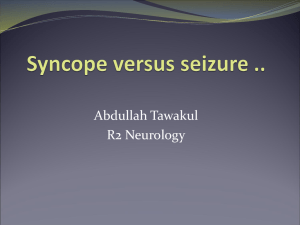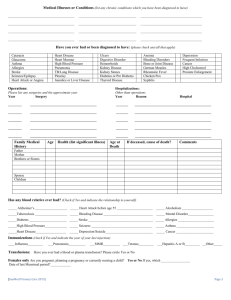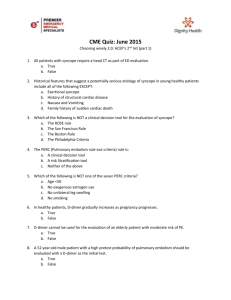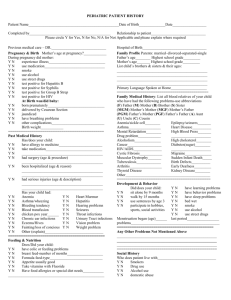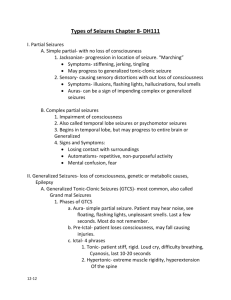Common Medical Emergencies for the General Dentist
advertisement
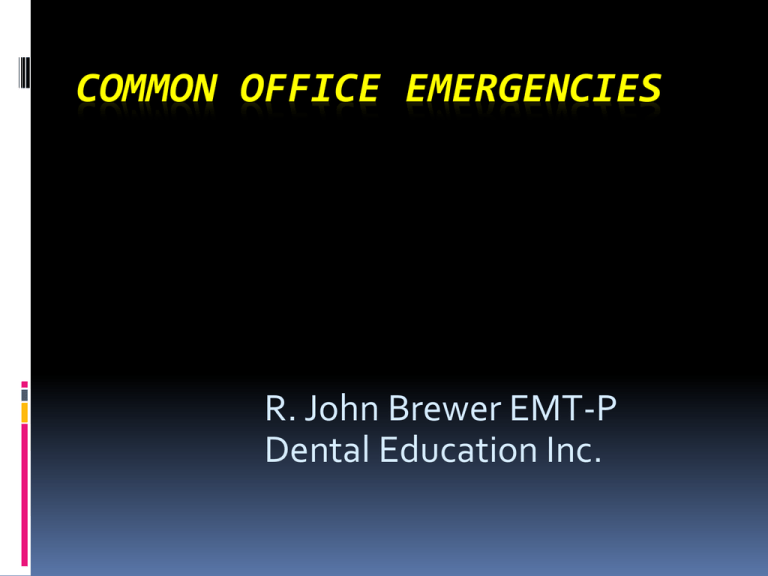
COMMON OFFICE EMERGENCIES R. John Brewer EMT-P Dental Education Inc. Blood Pressure - Hypertension Every office should establish guidelines for treatment What is the patient’s baseline pressure? If hypertension is noted, what is the cause? Is it acute or is it chronic? If it is acute without symptoms, allow the patient to rest and recheck in 5-10 minutes Blood Pressure - Hypertension If it persists, refer to physician If it resolves to baseline or near baseline proceed with treatment, if comfortable If it is acute with symptoms (headache, tinnitis) send to emergency department You can often be the first-line defense in referring patients with chronic blood pressure elevation to see a physician Hypertension Normal <130 Systolic < 85 Diastolic High Normal 130-139 85-89 Stage I HTN 140-159 90-99 150/90 > age 60 Stage 2 HTN 160-179 100-109 Hypertension Stage 3 HTN 180-209 110-119 patient should see MD within one week. Stage 4 HTN >210 => 120.00 Blood Pressure - Hypertension Treatment of hypertension Rest and relax, make sure patient took prescription medication. Contact physician, determine whether immediate consult or ED is warranted With symptoms, administer oxygen, monitor Nitroglycerin - sublingual tablet or spray (0.4mg) every 5 minutes as needed. Continue to monitor Postural Hypotension Also known as orthostatic hypotension. It is the second leading cause of loss of consciousness in the dental office. Postural hypotension is defined as a disorder of the autonomic nervous system in which syncope occurs when the patient assumes an upright position. Postural hypotension Postural hypotension may also be defined as a drop in blood pressure of 30mm hg or >10mm hg drop in diastolic pressure upon standing. Usually not associated with fear or anxiety. Knowing predisposing factors can allow the dentist to prevent this from occurring. Predisposing factors Administration and ingestion of drugs Prolonged period of recumbence or convalescence Inadequate postural reflex Late-stage pregnancy Advanced age Venous defects Addison's disease Physical exhaustion/starvation Blood Pressure - Hypotension For young healthy people, blood pressure can almost never be too low. For more medically compromised patients low blood pressure can be a problem With signs of mental status changes or dizziness, a low blood pressure can be a problem, again either acute or chronic. Postural Hypotension Patient will report feeling light headed or lose consciousness with positional changes. Return to supine position as quickly as possible. Symptoms will resolve rapidly. Raise chair back incrementally, sit with feet on floor, stand without walking. Resume standing position slowly Postural hypotension Management - Assess level of consciousness - Activate office emergency system - Place patient supine - CAB’s - 02 administration - 911 vs. discharge - Don’t allow patient to drive Postural hypotension Examples: Middle age male, semi reclined, injected with local. Dr. and eventually staff member walk out of room. Patient begins to feel funny, sits up, leans forward. A loud crash is heard next, staff finds patient unconscious and bleeding. Another example Elderly patient develops syncope whose recumbent blood pressure was 180/100 and dropped to 100/50 after standing. Middle age patient in chair for approx 1 hour stands up walks to reception desk while standing still feels faint loses consciousness. CHEST PAIN Chest Pain/Acute Coronary Syndrome Each year 1.1 million Americans suffer a heart attack. Approx 460,000 of these are fatal. Approx ½ of these deaths occur within the first hour of the onset of symptoms. National statistics show that approx. 5% of all AMI’s are misdiagnosed and discharged from the ED Results in the most malpractice dollars spent. Acute coronary syndrome ACS - a temporary or permanent blockage of a coronary artery. ACS can include unstable angina, STEMI, NSTEMI. Sudden cardiac arrest can occur with any of these conditions. Stable Plaque Unlikely to rupture Mainly made up of collagen-rich tissue that has hardened. Have a thick fibrous cap over the lipid core which separates it from contact with the blood. As these plaques increase in size, the artery becomes severely narrowed. Symptoms begin when approx 70% of the vessel is narrowed. Pathology The most common cause of ACS is plaque rupture. Two types of plaque Stable vulnerable Vulnerable Plaque These are plaques that are prone to rupture. Soft, and have a thin cap of fibrous tissue over the fatty center which separates it from the opening of the artery. Platelets stick to the damaged lining within 1- 5 seconds. Vulnerable Plaque “sticky platelets secrete many chemicals which include Thromboxane A2. This drug stimulates vasoconstriction, which in return decreased blood flow. Aspirin blocks the production of Thromboxane A2. This slows down the clumping of platelets and lowers the risk of complete blockage of the vessel. Causes of Plaque Rupture Severe emotional trauma Sexual activity Use of cocaine, marijuana, amphetamines Exposure to cold Acute infection Contributing factors Coronary spasm at the site of the plaque Effects of the other risk factors Blockage of Coronary Artery Two types: Complete which may result in STEMI or Sudden death. Partial –may result in no clinical signs or symptoms (silent MI) unstable angina, NSTEMI or even sudden death. Angina Pectoris Chest discomfort that occurs when the heart muscle does not receive enough oxygen. Angina is not a disease. It is a symptom of myocardial ischemia. Angina most often occurs in patients with know CAD, involving at least one coronary artery. Angina Common sites for pain include the following: upper chest, substernal radiating to neck and jaw. Beneath sternum radiating down left arm. Epigastric or epigastric radiating to neck, jaw, arms. Left shoulder pain Back pain between shoulder blades. Right arm pain. Angina - Terms used to describe discomfort: Heaviness Pressing Suffocating Squeezing Constricting Burning Grip like Band, weight, vise on or around chest Angina - Terms used to describe discomfort: Heaviness Pressing Suffocating Squeezing Constricting Burning Grip like Band, weight, vise on or around chest Angina Equivalents - Generalized weakness - Difficulty breathing - Diaphoresis - Nausea, vomiting - Dizziness - Syncope, or near syncope Angina - Palpitations - Isolated arm or jaw pain - Fatigue - Arrhythmias Angina Three Types: - Stable - Unstable - Prinzmetal’s Angina Stable - Constant, predictable in terms of severity - Signs symptoms, precipitating events, and response to treatment. - Usually lasts 2-5 minutes. Angina Remember, 1st sign of chest pain is often not angina when it occurs in the dental office Be careful with epinephrine dosage Healthy patients can receive .2 mg of epinephrine In cardiac patients stay below .04 mg Angina Unstable Condition between stable angina and acute MI. Occurs most often in men and women between ages of 60-80 who have one or more major risk factors of CAD. Patients with untreated unstable angina are at high risk of heart attack or death. Unstable Angina Unstable angina symptoms usually occur at rest. These symptoms last > 20 minutes. These symptoms are new maybe over the past several weeks becoming progressively worse. Prinzmetal’s Angina Defined as intense spasm of segment of coronary artery. May occur in healthy individuals between 4050 years of age, with no CAD. Prinzmetal’s Occurs at rest Occurs in the early morning hours and may awaken patient from sleep. Episodes may only last a few minutes but may be long enough to cause v-fib,v-tach, and sudden death. If spasm persists may cause infarct. Myocardial Infarction Ischemia prolonged more than just a few minutes results in myocardial injury. Injury refers to myocardial tissue that has been cut off from its blood or oxygen supply. Injured cells are alive but will die (infarct) if ischemia is not quickly corrected. The corrective actions include: fibrinolytics, angioplasty, stent, CABG M.I. We should think of MI as a continual process, not as a dead heart. If efforts are made to recognize and treat promptly, the loss of heart muscle may be avoided. MI Most MI’s result of a Thrombus . Less common it is a result of coronary spasm. Ex. Cocaine abuse. Nearly 10% of MI’s occur in people under 40. Nearly 45% of MI’S occur in people under 65. 60% of all MI’s arrive in ED by private vehicle. MI Initial Management CAB’s Oxygen 2-4 liters via nasal cannula Vital signs ( pulse, blood pressure) SAMPLE History Treating the MI Call 911 Oxygen Aspirin 3-4 81 mg chewable allows for quicker absorption can rival fibrinolytic therapy in its impact on mortality reduction. Treatment Nitroglycerine 0.4mg sub lingual Relaxes smooth muscle Results in Venodilation Decreases oxygen demand NTG Prior to administering NTG : Systolic BP> 100 Heart rate >50 < 100 Patient has not used Viagra, Cialis ,Revatio with the past 24-48 hours. Repeat ntg q. 5 min. as long as BP> 100 Cardiac Arrest Heart rhythms can be shockable.(V-fib/V Tachycardia) Heart Rhythms can be non-shockable( asystole/PEA Patient will be immediately unconscious Assess CAB’s Call 911/ Get AED Begin Chest Compressions Cardiac Arrest Attach AED (automated external defibrillator) Follow voice prompts from defibrillator Continue Chest Compressions Begin Ventilations If trained advanced airway placement(I-Gel) RESPIRATORY SYSTEM ASTHMA Asthma Is a very common medical emergency Approx. 17 million Americans suffer from asthma. There are more than 2 million visits to the ED with asthma. Approx. 5000-6000 deaths each year. Asthma is defined as a chronic inflammatory disorder of the airways. This inflammation results in airflow obstruction. Asthma attacks are reversible, they are usually brought on by one of the 3 “Ss” Spasms Swelling Secretions Asthma is categorized into two types. - Extrinsic Asthma - Intrinsic Asthma Extrinsic Asthma Also known as allergic asthma 50% of asthmatics have this form or asthma. Most common in children and young adults. Extrinsic asthma The allergen may be airborne such as dust, latex. Etc….. The allergen may be ingested such as foods, medications. Once exposed bronchospasm can develop within minutes. Intrinsic Asthma Affects the other 50% of asthmatic patients Usually develops in older adults > 35 years of age. Also known as nonallergic, idiopathic, or infective asthma. Intrinsic asthma Causes: -viral infection is most common - Exercise induced - Psychological and physiologic stress Status Asthmaticus Most severe form of asthma Experience wheezing, dyspnea, hypoxia that are refractory to B-adrenergic agents. This is a true medical emergency Asthma Signs and Symptoms Chest congestion Anxiety Cough Apprehension Wheezing Tachypnea Dyspnea Increase in BP Use of accessory muscles Tachycardia Confusion Diaphoresis Retractions Cyanosis Nasal Flaring management Terminate dental procedure 911 Position of comfort Reassure patient Oxygen Administration Albuterol 2.5mg/3cc nss via 02 powered nebulizer at 6 liters per minute. Or 2 puffs of ventolin inhaler. If severe enough, epinephrine .3 mg IM (1:,1000) Emphysema “Pink puffers”, barrel chest Not likely to see an acute emergency from emphysema Treat as upright as possible If there is breathing difficulty with the patient, have him/her exhale through pursed lips Oxygen never hurts 2.5 mg albuterol/3cc nss via 0xygen powered nebulizer @ 6lpm. Chronic Bronchitis “Blue Bloaters” Again, not a disease that will cause an acute emergency Treat as upright as possible 2.5mg albuterol/3cc nss via o2 powered nebulizer @ 6 liters per minute. Aspiration Foreign body airway obstruction Most cases can be avoided with diligent suctioning or use of ligatures If object goes missing it will end up in several different places Back of throat Larynx Lungs Stomach Aspiration All objects must be accounted for Even if patient says he/she did not swallow or aspirate object, a chest x-ray must be done to confirm whereabouts If swallowed follow-up for several days If fully aspirated, treatment will depend on location, size, and type of material Aspiration Objects that get lodged in the larynx will cause either full or partial airway obstruction Allow patients to manage a partial airway obstructions as long as they can phonate or until lose of consciousness Full airway obstruction must be managed immediately with the Heimlich maneuver Aspiration As long as the patient is conscious, he will want to sit or stand up, let him . Once consciousness is lost, supine position, begin 30 chest compressions, look in airway , and attempt to ventilate. Repeat procedure until object is dislodged or able to ventilate. Dyspnea Dyspnea is one of the most common medical complaints. Usually described as “short of breath.” Not associated with any one disease Many different causes: CVS, CNS, RS, endocrine system, immune system Any mechanism that causes hypoxia. Dyspnea The Dyspnea may be mild, to severe. The dyspnea may occur with exertion or may start while at rest. Dyspnea Immediate concerns include: -Is the airway patent and stable? What is the rate and depth of respirations Is the patient hypoxic Normal or abnormal breath sounds. Dyspnea History of Respiratory disease? Onset sudden or gradual? Any chest pain? Evidence of infection? What medications? Dyspnea differential diagnosis Pulmonary etiologies -Acute Asthma -Anaphylaxis - Aspiration - Pulmonary embolism Differential diagnosis Cardiac etiologies - Acute MI - Pulmonary Edema Differential Diagnosis Non Cardiac and Non Pulmonary causes - Anemia - Hyperventilation Dyspnea Key Physical Findings -Mental Status - Look for signs of shock - vital signs including lung sounds Dyspnea Key Physical Findings - Skin - Accessory Muscles - extremities Treatment Administer oxygen Monitor closely Call for assistance If significant respiratory distress is present, patient may stop breathing or gasp (agonal) If respirations are not sufficient to maintain oxygenation, assist with positive pressure If breathing stops, maintain at rate of 12-20 per minute, do not forget about checking CVS CENTRAL NERVOUS SYSTEM Hyperventilation Brought on by anxiety, it is a very common medical emergency in the dental office. Occurs in the apprehensive patient who attempts to hide their fears. More common in young females Hyperventilation Hyperventilation occurs when respiration exceeds the metabolic demands of the patient. The concentration of carbon dioxide in the blood is reduced below base levels. Manifested by increase in tidal volume, rate or both. Hyperventilation Characterized by rapid breathing, chest pains Numbness to extremities, muscle pain, cramps Feeling faint, lightheaded, dizzy, Nervousness, anxiety Tingling around mouth Hyperventilation In a purely anxious patient the excess elimination of CO2 causes respiratory alkalosis. This in return causes hypocalcemia. This hypocalcemia results in cramping of the muscles in the hands and feet. This is known as carpal-pedal spasms. Hperventilation However Hyperventilation may be a sign of other medical problems. Hyperventilation should always be considered a major medical problem until proven otherwise. Hyperventilation Other causes include the following: cardiovascular causes CNS emergencies CHF COPD Drugs, Fever Hypotension Hypoxia Metabolic disorders Pain Lung problems Hyperventilation Management The goal should be to correct the respiratory problem, and to reduce anxiety. Therefore the first step is to stop the dental procedure. Place patient in position of comfort. management Monitor ABC’s Coach breathing 02 at low flow with mask(1-2 liters) NEVER NEVER have patient breath into paper bag. !!! If symptoms do not resolve contact 911. SYNCOPE Syncope defined A neurological condition characterized by the sudden, temporary loss of consciousness caused by insufficient blood flow to the brain. Usually recovery is almost immediate upon becoming supine. If a patient does not spontaneously regain consciousness within a few moments(usually less that 1 minute) it is NOT syncope, it is something more dangerous. syncope ½ of all Americans will experience at least one episode of syncope during their lifetime. According to the National Institutes of Health, Syncope accounts for 3% of all emergency dept. visits. Most Common emergency in the office Predisposing factors Anxiety, stress, pain Sight of blood or dental syringe Erect sitting or prolonged standing Hunger and exhaustion Hot humid crowded environment Phases of Syncope Pre-Syncope Syncope Post -Syncope Pre-Syncope Anxiety, stress , pain triggers the “flight, fight response” Rapid release of epinephrine and norepinephrine Blood pools in periphery Signs,symptoms pre syncope Warm flushed feeling face and neck Pale ashen skin color Cold diaphoretic Nausea Lightheaded Pupils dilate Yawning Tachycardia with slight hypotension Syncope phase Patient loses consciousness Generalized relaxation of muscles Bradycardia Seizure Eyes open with upward gaze Post syncope phase Rapid return to consciousness if treated properly If LOC> 1 min. EMS needs to be contacted immediately if not already contacted. Short period of confusion Headache may persist for hours Slow return to pre syncope heart rate and blood pressure. Types of Syncope Vasovagal syncope Cardiac syncope Orthostatic syncope Neurogenic/neurologic Miscellaneous Vasovagal Most common More common in young males Most benign “simple fainting” Differential diagnosis: remember with simple fainting the patient is ALWAYS sitting erect or standing when symptoms occur. Cardiovascular syncope Mechanical problems Dysrhythmias - Bradycardia vs. tachycardia Heart rates < 50 and greater than 150 should be a concern and may be signs of serious cardiac event. Orthostatic hypotension Syncope when going from a sitting or supine position to a standing position. May be caused by hypovelemia/dehydration Medications that reduce vasoconstriction such as ACE inhibitors may make patients prone to these orthostatic changes. Examples of ACE are:enalapril,captopril,lisinopril ramipril Neurogenic/neurologic Stroke is a rare cause of syncope A subarachnoid hemorrhage can cause syncope followed by a severe headache. Carotid sinus syndrome (turning the head to one side)may cause syncope Miscellaneous causes Hypoxia Hypoglycemia hyperventilation Critical points Any patient developing syncope without warning symptoms , or while in the supine position must be assumed to have a cardiac cause for syncope until proven otherwise. Positive orthostatic vital sign changes in a patient are a strong indication of decreased circulating blood volume. treatment Stop all dental work Remove objects from mouth Place patient supine Maintain airway using head tilt –chin lift method. Administer 0xygen- assist ventilations if needed Vitals- pulse, resp. BP. Monitor, Always remember to call 911 Preventing syncope Comfortable temperature in operatory Supine position Avoid hypoglycemia Supplemental oxygen therapy Stress reduction protocol STROKE Stroke A sudden change in neurologic function caused by a change in cerebral blood flow. A stroke is also called a “ Brain Attack” Stroke facts Patients who have a-fib are 5-17 times more likely to develop a stroke than those who do not have a-fib. About 1-2% of all patients who an acute MI have a subsequent stroke within the first month after their cardiac event. Half of these occur with the first 5 days of the MI Types of Stroke Ischemic Hemorrhagic Ischemic Stroke Accounts for approx. 80% of all strokes Two types of Ischemic Strokes -Thrombotic -Embolic Embolic Stroke Clots arise elsewhere in the body and migrate to the brain. (Cerebral embolism) Thrombotic Stroke Most common cause of stroke Atherosclerosis of large vessels in the brain causes progressive narrowing and platelet clumping. Blood clots develop within the brain artery itself ( cerebral thrombosis) Symptoms of Stroke Paralysis or weakness Altered mental status including impaired memory and / or judgment. Sensory deficits Impaired gait Symptoms of Stroke Visual disturbances Pinpoint, dilated or unequal pupils Aphasia Slurred speech Difficulty in speaking, getting thoughts out Symptoms of Stroke Vertigo Syncope Vomiting Headache Symptoms of Stroke Seizures Unconsciousness Bowel or bladder incontinence Abnormal respiratory patterns Acute Stroke- Early Diagnosis Trauma - “ Golden Hour” Heart Attack - “Time is Muscle” Stroke - “Time is Neurons” “Time is Brain” Stroke Early Recognition/Treatment The earlier the intervention, the better the results Window of opportunity to use tPA < 4 1/2 hours required for IV fibrinolytic therapy <6 hours required for intra-arterial fibrinolytic therapy Hemorrhagic Stroke Spontaneous intracranial hemorrhage responsible for 8-11% of all acute strokes. Bleeding forms a hematoma that causes local injury, decreased tissue perfusion and increased intracranial pressure. Predisposing conditions include HTN, oral contraceptives, cocaine use and anticoagulant and antiplatelet agents. Stroke-Chain of recovery Identify Dispatch EMS arrival Alert Stroke Team Diagnosis and Treat Transport and Evaluation Rehab Cincinnati Prehospital Stroke Scale Facial droop/weakness - Ask patient to “smile for me” - Motor weakness(arm drift) - With eyes closed, ask patient to extend arms in front of him or her. - Aphasia or slurred speech. Stroke- Initial Care Assess CAB’s and vital signs , check BP in both arms. Check pulse ox and administer 02 as indicated Start IV, and check blood glucose SEIZURES Seizures Defined as a temporary alteration in behavior due to the massive electrical discharge of one or more groups of neurons in the brain. Causes of Seizures May be brought on by stressors to the body. Examples include - Hypoxia - Hypoglycemia - Hypothermia - Hyperthermia Causes of Seizures Seizures may also be caused by diseases such as: Tumors Head Trauma Toxic Eclampsia Vascular disorders The most common however is Idiopathic Epilepsy. Types of Seizures Generalized seizures - Tonic-Clonic - Absence Partial Seizures - Simple partial seizures - complex partial seizures SEIZURES Tonic Clonic – also known as a grand-mal seizure is generalized motor seizure producing a loss of consciousness. The patients intercostal muscles, diaphragm become temporarily paralyzed, interrupting respirations and produces cyanosis. Phases of generalized seizures Aura Loss of consciousness Tonic phase Hypertonic phase Clonic phase Post seizure Postictal Phases of generalized seizures Aura Loss of consciousness Tonic phase Hypertonic phase Clonic phase Post seizure Postictal Absence Seizures Absence seizure also known as petit mal seizure. Described as a 10-30 second second loss of consciousness or awareness. Idiopathic disorder of childhood, rarely occurs after the age of 20. Pseudo seizures Pseudo seizures are also know as "hysterical seizures.” Occur as a result of psychological disorder. Patients present with sharp bizarre movements which can be interrupted with a tense command . Partial Seizures There are two types of Partial seizures. Simple partial seizures Complex partial seizures Simple Partial Seizures Also known as focal seizures. Characterized by chaotic movement of one area of the body. They may progress to generalized seizures. It is very important to document how seizures begin and the progression they take. Complex Partial Seizures Complex partial seizures are also know as temporal lobe or psychomotor seizures. Characterized by distinctive auras such as unusual tastes, smells, or sounds. Seizures usually last 1-2 minutes. Patient may act confused, stagger perform purposeless movement, or make unintelligible sounds. Some patients show sudden change in personality. Assessment of the Seizure Patient Many medical emergencies may mimic a seizure. - migraines -cardiac emergencies - hypoglycemia - drug ingestion syncope assessment A good history will help you determine if it is a true seizure. Some important information that should be obtained is the following: History of Seizures Recent history of head trauma Recent history of fever, headache, stiff neck History of diabetes , heart disease , stroke Current medications Seizures Commonly seizures occur in a patient who is non compliant with medications, or needs an adjustment in dosage or intervals. Seizure vs. Syncope Seizures typically involve tongue biting, incontinence and a period of postictal confusion. Seizure etiologies Primary seizures –(Epilepsy) unprovoked, intermittent, recurring seizure activity. Secondary- predictable responses to toxins, or environmental or pathophysiological events. Hypoxic seizures- caused by inadequate airway or ventilation. Seizure etiologies Alcohol or drug induced – look for signs of overdose, pertinent history of alcohol or drug abuse. Intracranial insults- infections, trauma, strokes, tumors. Fever Eclampsia- Managing the Seizure Patient Call 911 Maintain airway Administer High flow oxygen Establish IV NSS Determine Blood Glucose Maintain body temperature Suction if needed If seizure > 5min.consider anticonvulsant . Versed 1-2mg IV Push or IN Can be repeated after 10 minutes Loss of Consciousness May result from systems other than central nervous system: Respiratory - asthma, aspiration Cardiac - arrhythmia, cardiac arrest, orthostasis Endocrine - hypoglycemia, thyroid Metabolic - electrolyte abnormalities, dehydration Drugs Behavioral (Pseudo Seizures) Loss of Consciousness Until diagnosis is made, treat all LOC patients the same way Supine position, preferably on the floor Good airway management, will often be enough to keep patient breathing or even arouse patient Ventilate if needed Check circulation Overdose Narcotic overdose - Airway - Support Ventilations - 911 ENDOCRINE SYSTEM Diabetes Disease where sugar is available in the system but not to the cells Type I - “insulin dependant diabetes” Do not produce any insulin Will need insulin to force sugar into the cells More fragile than type II Have significantly more systemic problems Diabetes May have peripheral neuropathies, renal failure (dialysis), retinal degeneration, atherosclerosis, poor circulation (ulcerations, amputations) The more of these, the worse off the patient is Physician consultation may not be a bad idea Type II - “non-insulin dependant diabetes”, now see a lot of patients on insulin, do produce insulin, but not enough Diabetes Not as fragile Will tolerate periods of hypoglycemia better Not as many significant systemic issues Treat all diabetics on their normal schedule Unless there is reason for it, make sure they take their medications and eat a normal diet May need to work around dialysis schedule Diabetes Signs and symptoms of Hypoglycemia: Confused, unconscious Shallow respirations Pale, cool, damp Increased heart rate and blood pressure Blood Glucose < 80mg/dl Signs and symptoms of Hyperglycemia: Confused, unconscious Increased respirations and heart rate Pale, warm, dry Decreased blood pressure Hypoglycemia Usually seen in diabetic patients, but not always Diabetic will take insulin or oral hypoglycemic medication and not eat Often seen with patients that are in pain and not on a normal diet Be careful with long appointments, allow time to eat or drink if possible Hypoglycemia Most diabetics will be able to tell when their sugar is low As long as they are conscious, administer an oral sugar source: Fruit drink Cake icing Hypoglycemia Symptoms should resolve fairly quickly Cancel appointment and watch for approx. 30 minutes. Attempt to have someone drive patient home. If patient is unconscious: 911 IMMUNE SYSTEM Allergic Reactions Several different types and severities of hypersensitivity reactions Type I reactions - anaphylaxis/immediate Type II reactions - usually associated with blood products Type III reactions - onset may not be seen for several weeks - serum sickness or nephritis Type IV reactions - delayed hypersensitivity, 24-72 hours after skin contact - latex Allergic Reactions Our concerns are mostly with Type I and IV reactions Obviously, a good medical history will help prevent or eliminate most allergic reactions As a general rule, reactions will be much more severe with IV or IM applications than with oral or topical applications Allergic Reactions Treatment of Type I reactions Recognition Severe anaphylaxis will manifest in all major systems: Respiratory - wheezing, laryngeal edema, respiratory distress, airway obstruction Skin - angioedema, pruritis, flushing, lesions Cardiovascular - hypotension, tachycardia, dizziness, syncope, cardiovascular collapse Allergic Reactions With appearance of even some of these signs, treat aggressively Stop administration of suspected agent(s) Initiate BLS protocol - CAB’s, oxygen 911 Epinephrine - .3mg IM (1:1,000) Allergic Reactions Administer diphenhydramine, 25-50 mg IM In a conscious patient with respiratory difficulty, give nebulized albuterol if available or 4-8 puffs of inhaler. May need to give positive pressure to assist with respirations Allergic Reactions With less severe or delayed allergic responses give PO diphenhydramine, 25-50 mg orally every 4-6 hours Alert physician to patient status Follow-up with phone call later Tell patient that if symptoms worsen call 911. Latex Sensitivity Normally manifests itself as a delayed hypersensitivity reaction Signs of contact dermatitis will show 4-6 hours after exposure and peak within 48 hours Usually a sharp line where the latex was in contact with the skin Latex Sensitivity Treatment is the same as for a minor allergic reaction, PO diphenhydramine, 25-50 mg every 4-6 hours Prevention is the best treatment Avoid latex gloves, rubber dams Susceptible patients will report allergies to avocados, bananas, chestnuts, will have worked in health care or around natural rubber, or have spina bifida Methemoglobinemia Blood disorder in which an abnormal amount of methemglobin is produced. The Hemoglobin is unable to release oxygen effectively to the bodies tissues. Methemoglobinemia Two Type: Inherited Acquired Acquired is the most common. Methemoglobinemia ACQUIRED Caused by exposure to certain drugs, chemicals or foods. Most common cause in dental office would be the topical (Benzocaine) Methemoglobinemia Symptoms -Bluish color of the skin - Headache - Fatigue - Dyspnea - Lack of energy - Blood appears chocolate colored Methemoglobinemia Symptoms - Abnormal cardiac rhythms - Altered level of consciousness - Seizures Methemoglobinemia TREATMENT 911 CAB’s - Methylene Blue - Hyperbaric oxygen Therapy QUESTIONS?
